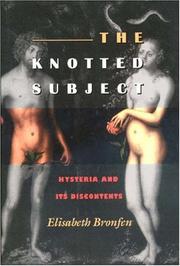| Listing 1 - 2 of 2 |
Sort by
|
Book
Year: 2014 Publisher: Brooklyn, NY punctum books
Abstract | Keywords | Export | Availability | Bookmark
 Loading...
Loading...Choose an application
- Reference Manager
- EndNote
- RefWorks (Direct export to RefWorks)
Benjamin Christensen's 1922 Swedish/Danish film Häxan (known under its English title as Witchcraft Through the Ages) has entranced, entertained, shocked, and puzzled audiences for nearly a century. The film mixes documentary with fantasy, history with theatrics, religion and science, the medieval past and modern culture. This uncanny content is compounded by the film's formal strangeness, a mixture of quasi-documentary with fictional episodes, illustrated lectures alongside docudrama recreations and dreamscapes. Is this a documentary, a horror flick, or both? In this chapbook, authors Doty and Ingham argue that the puzzle of Christensen's Häxan might be unraveled by attending to the film's provocative and paradoxical medievalism, its fantasmatic rendering of the witch as a medieval monster. Such monstrous medievalism, moreover, sheds considerable light on the politics of gender and culture once the witch is rendered a female figure in a time-out-of-joint.
Civilization, Medieval --- Hysteria in motion pictures. --- Motion pictures --- Witchcraft --- Witches in motion pictures. --- Psychological aspects. --- History. --- Christensen, Benjamin, --- Criticism and interpretation. --- Häxan (Motion picture) --- film --- medieval studies --- horror --- cultural studies --- witchcraft

ISBN: 069101230X 0691012318 9780691012308 0691608377 1400864739 130698386X 0691636842 9781400864737 9780691012315 9780691608372 Year: 1998 Publisher: Princeton, N.J. Princeton University Press
Abstract | Keywords | Export | Availability | Bookmark
 Loading...
Loading...Choose an application
- Reference Manager
- EndNote
- RefWorks (Direct export to RefWorks)
Surrealist writer André Breton praised hysteria for being the greatest poetic discovery of the nineteenth century, but many physicians have since viewed it as the "wastebasket of medicine," a psychosomatic state that defies attempts at definition and cure and that can be easily mistaken for other pathological conditions. In light of a resurgence of critical interest in hysteria, leading feminist scholar Elisabeth Bronfen reinvestigates medical writings and cultural performance to reveal the continued relevance of a disorder widely thought to be a romantic formulation of the past. Through a critical rereading, she develops a new concept of hysteria, one that challenges traditional gender-based theories linking it to dissatisfied feminine sexual desire. Bronfen turns instead to hysteria's traumatic causes, particularly the fear of violation, and shows how the conversion of psychic anguish into somatic symptoms can be interpreted today as the enactment of personal and cultural discontent.Tracing the development of cultural formations of hysteria from the 1800s to the present, this book explores the writings of Freud, Charcot, and Janet together with fictional texts (Radcliffe, Stoker, Anne Sexton), opera (Mozart, Wagner), cinema (Cronenberg, Hitchcock, Woody Allen), and visual art (Marie-Ange Guilleminot, Cindy Sherman). Each of these creative works attests to a particular relationship between hysteria and self-fashioning, and enables us to read hysteria quite literally as a language of discontent. The message broadcasted by the hysteric is one of vulnerability: vulnerability of the symbolic, of identity, and of the human body itself.Throughout this work, Bronfen not only offers fresh approaches to understanding hysteria in our culture, but also introduces a new metaphor to serve as a theoretical tool. Whereas the phallus has long dominated psychoanalytical discourse, the image of the navel--a knotted originary wound common to both genders--facilitates discussion of topics relevant to hysteria, such as trauma, mortality, and infinity. Bronfen's insights make for a lively, innovative work sure to interest readers across the fields of art and literature, feminism, and psychology.Originally published in 1998.The Princeton Legacy Library uses the latest print-on-demand technology to again make available previously out-of-print books from the distinguished backlist of Princeton University Press. These editions preserve the original texts of these important books while presenting them in durable paperback and hardcover editions. The goal of the Princeton Legacy Library is to vastly increase access to the rich scholarly heritage found in the thousands of books published by Princeton University Press since its founding in 1905.
Psychological study of literature --- Thematology --- Film --- Depth psychology --- Hysteria --- Hysteria in literature --- Hysteria in motion pictures --- Hysterical neuroses --- Hysterie --- Hysterie in de film --- Hysterie in de literatuur --- Hystérie --- Hystérie dans la littérature --- Hystérie dans le cinéma --- 82:159.9 --- Literatuur en psychologie. Literatuur en psychoanalyse --- Hysteria in literature. --- Hysteria in motion pictures. --- Hysteria. --- Navel --- Psychoanalyse --- Symbolic aspects. --- cultuur en religie --- 82:159.9 Literatuur en psychologie. Literatuur en psychoanalyse --- cultuur en religie. --- Mass Media --- Histrionic Personality Disorder --- History --- Philosophy --- Humanities --- Abdomen --- Audiovisual Aids --- Personality Disorders --- Educational Technology --- Teaching Materials --- Communications Media --- Body Regions --- Technology --- Information Science --- Mental Disorders --- Anatomy --- Technology, Industry, and Agriculture --- Psychiatry and Psychology --- Technology, Industry, Agriculture --- Motion Pictures as Topic --- Symbolism --- Umbilicus --- Literature --- Psychiatry --- Health & Biological Sciences --- Psychiatric Disorders, Individual --- Symbolic aspects --- Belly button --- Omphalos --- Hysteric passion --- Hysterica passio --- Hysterical neurosis --- Hysterical passion --- Passio hysterica --- Vapors (Disease) --- Vapours (Disease) --- Umbilical cord --- Motion pictures --- Neuroses --- Ecstasy --- Navel - Symbolic aspects.
| Listing 1 - 2 of 2 |
Sort by
|

 Search
Search Feedback
Feedback About UniCat
About UniCat  Help
Help News
News